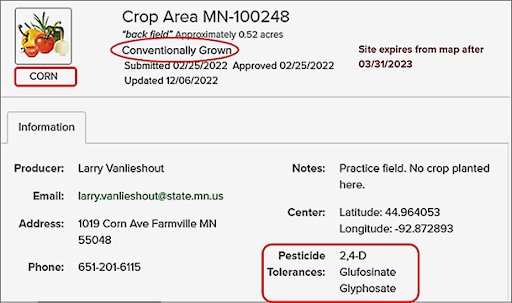Larry VanLieshout - Minnesota Department of Agriculture
The DriftWatch program provides a way for Minnesota crop producers to communicate information about their crop locations and herbicide sensitivity to pesticide applicators. This is done by posting their crop information on the interactive online FieldWatch map. Pins on the map show the locations of producer submitted fields and beehives (Fig. 1). Selecting a pin brings up additional information about the site. Users can zoom in on a pin to view the field borders and the surrounding land use (Fig 2). Pesticide applicators can use the FieldCheck program to view this information prior to spraying and take needed precautions to avoid drift to sensitive sites. BeeCheck is a companion program used by beekeepers to mark the location of their hives on the map. DriftWatch, BeeCheck, and FieldCheck are all free, voluntary programs managed by FieldWatch, a nonprofit company.
DriftWatch became available for use in Minnesota in 2011. It was originally designed for specialty crops such as fruits, vegetables, organic crops, nursery crops, and others. In addition to visually surveying an area for sensitive crops and beehives prior to spraying, applicators were advised to check the FieldWatch map.
 |
| Figure 1. Sample FieldWatch map of Minnesota. |
 |
| Figure 2. Sample map showing neighboring fields and crop types with and nearby honeybee hives. |
With the advent of herbicide tolerant crops, it is no longer possible for applicators to differentiate between tolerant and susceptible plants by visual inspection. In response to this issue, some field crops (e.g., corn and soybeans) were added to the DriftWatch crops menu. In addition, herbicide tolerances for these field crops can be designated so applicators are aware of their herbicide sensitivity. The herbicide tolerances for the Minnesota field crops are listed by active ingredient in the table below.
Herbicide tolerance option for corn and soybeans in
DriftWatch.
|
Corn Options |
Soybean Options |
|
2,4-D |
2,4-D |
|
ACCase (sethoxydim) |
Conventional/non-GMO |
|
Conventional/non-GMO |
Dicamba |
|
Glufosinate |
Glufosinate |
|
Glyphosate |
Glyphosate |
|
|
HPPD (mesotrione) |
|
|
Isoxaflutole |
|
|
STS (Sulfonylurea) |
Crop producers select all tolerances that apply to their crop. The “conventional/non-GMO” option is for crops without herbicide resistant traits. If crop producers are familiar with herbicide tolerant trait packages rather than herbicide active ingredients, the University of Minnesota Extension has a thorough review of herbicide tolerant traits on their website and in Bulletin PS-1945.
Once posted on the FieldWatch map, pesticide applicators can select the icon for that site to obtain crop, herbicide tolerance, and producer information (Fig. 3). The producer’s contact information is particularly helpful for informing beekeepers of planned insecticide application so that hives can be moved, covered, or screened. Also, some product labels require applicators to check their state’s “sensitive crop registry”, such as FieldWatch, in addition to visually surveying adjacent fields prior to making an application. This requirement is on over-the-top dicamba product (Engenia, XtendiMax, Tavium) and 2,4-D product (Enlist Duo, Enlist One) labels.
 |
| Figure 3. Sample FieldWatch location information. |
There are few restrictions on DriftWatch submissions. The program is for commercial producers and sites must be at least half an acre in size. It is not intended for home gardens. However, any size apiary can post their beehive locations. To keep the map current, sites expire after one growing season and need to be updated and renewed annually.
Crops and herbicide tolerances on the FieldWatch map are self-reported and not verified. Changes can occur prior to planting and may not be updated on the map. So, applicators should always follow required setbacks and drift control procedures.
For more detailed information on using these programs, refer to: User Guide: How to Register Your Crops and Beehives in FieldWatch. DriftWatch information and videos can also found on the Minnesota Department of Agriculture (MDA) websites. If additional assistance is needed, contact Larry VanLieshout, MDA, larry.vanlieshout@state.mn.us, 651-201-6115.
Webpages referenced:
Comments
Post a Comment